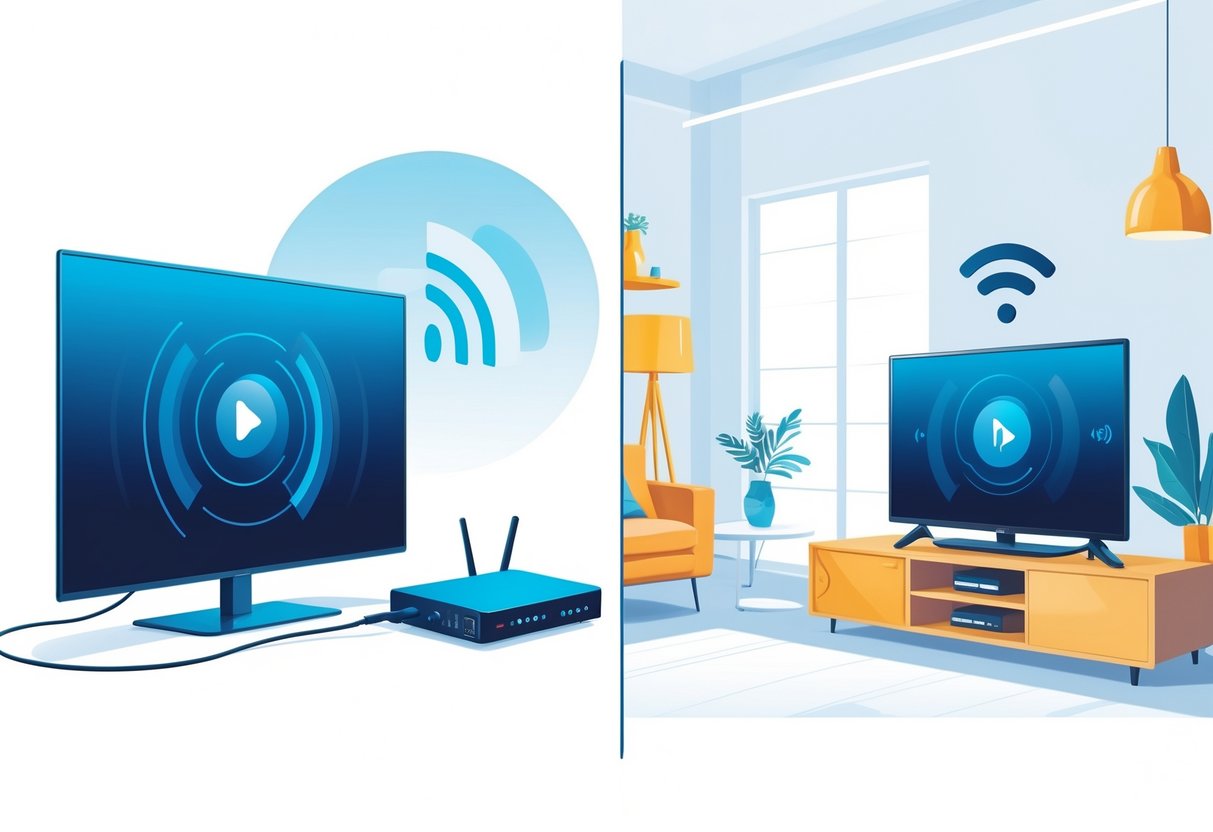
Optimizing Network Hardware and Placement
To achieve faster and smoother TV streaming, network hardware and its placement play a major role. Both the location of the router and the quality of devices like smart TVs and streaming boxes directly impact Wi-Fi signal strength and performance.
Router Placement for Stronger Wi-Fi Signal
Placing a Wi-Fi router in a central, open location can often mean the difference between constant buffering and seamless streaming. Obstacles such as walls, floors, and furniture block and weaken the Wi-Fi signal, especially in larger homes.
Keeping the router off the ground and away from other electronics helps reduce interference. Users should avoid placing routers inside cabinets or behind TVs, as this absorbs and scatters the signal.
For homes with dead zones or weak spots, using Wi-Fi extenders or mesh systems can maintain strong coverage throughout every room. Signal strength directly affects streaming quality, so placing the router optimally improves the connection for all devices, including smart TVs and streaming sticks.
When multiple devices are connected, congestion can occur. Limiting bandwidth use on non-essential devices or scheduling downloads outside of prime streaming hours can further enhance the streaming experience.
For more tips on stronger connections, visit this detailed guide to reducing buffering issues.
Upgrading Your Router or Streaming Device
Outdated routers often struggle to keep up with the demands of high-definition and 4K streaming. Upgrading to a modern router with dual-band or tri-band capabilities reduces network congestion and boosts overall speed.
Devices with Wi-Fi 6 or Wi-Fi 6E compatibility can deliver more robust connections for smart TVs and streaming boxes. Older streaming devices may not support the latest streaming protocols or higher resolutions, resulting in more buffering or degraded image quality.
Replacing them with newer models ensures compatibility with advanced Wi-Fi networks and streaming services. Wired Ethernet connections, when possible, offer the most reliable speeds—bypassing Wi-Fi limitations altogether.
Consider adjusting router settings to prioritize streaming traffic or enabling Quality of Service (QoS) features. These features help direct more bandwidth to TVs and streaming devices during peak hours.
For those unsure about what upgrades will help, many providers offer compatibility lists and suggestions at the point of sale or in their online support sections. Find more information on upgrading routers and devices for optimal streaming.
Choosing Between Wired and Wireless Connections

The quality of your internet connection plays a critical role in streaming TV shows without lag or interruptions. Reliable streaming depends on both the type of connection you use and the strength of your signal throughout your home.
Benefits of Wired Connections for Streaming
A wired connection, such as Ethernet, offers a more stable and consistent streaming experience compared to Wi-Fi. Unlike wireless networks, Ethernet cables are not affected by interference from walls, electronic devices, or distance within a household.
Streaming over a wired connection often yields faster data transfer speeds and lower latency. This means users are less likely to experience buffering or sudden drops in video quality.
For those watching high-definition or 4K content, Ethernet can provide the bandwidth required for smooth playback, as highlighted in CNET’s guide to improving TV streaming quality.
Many modern streaming devices and smart TVs support Ethernet, making it straightforward to connect directly to your router. Using a wired internet connection is especially useful in homes where multiple devices compete for bandwidth on Wi-Fi.
Minimizing Wi-Fi Interference
While Wi-Fi offers greater flexibility and convenience, it is more susceptible to interference and signal loss. Signal strength may drop due to physical obstacles, such as walls or floors, or electronic interference from other devices like microwaves or cordless phones.
Improving Wi-Fi performance can involve simple steps:
- Move closer to the router to boost signal strength.
- Place your router in a central, open location for wider coverage.
- Limit devices using the same network to reduce congestion.
- Upgrade your router if it’s outdated, as newer models handle high-traffic demands better.
Sitting close to your Wi-Fi router can significantly improve your internet connection, reducing buffering when streaming TV shows, as suggested by expert advice on Quora. Taking these steps can help create a smoother streaming experience even on wireless networks.



